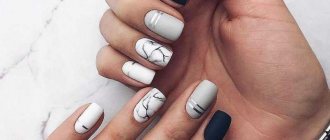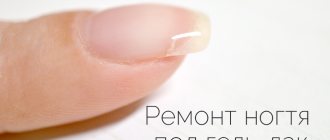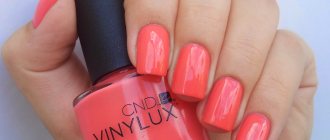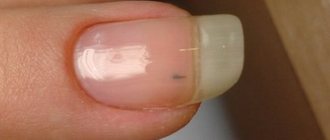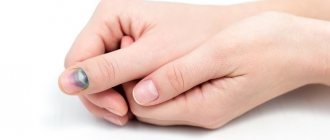The hands of a business woman are her calling card when communicating with partners, clients and company management, so her hands and nails are always “under the gun.” Every detail is impeccable, so even a business manicure should be appropriate. Well-groomed nails and skin, the nail design of a successful woman should be fashionable, but at the same time not violate the usual rules of the office manicure “dress code”. Even a discreet, calm manicure can be elegant and stylish. Taking into account all of the above, we have compiled a number of recommendations on how to do a manicure without a manicure.
Varnish/gel polish coating and design.
We offer business style ideas:
Natural nude.
A business-style manicure should be done in calm, restrained colors: beige, soft pink, cream, milky, ivory. A nude manicure creates the effect of the absence of any coating on the nails. But natural shades can create the impression of healthy, well-groomed, beautiful nails. You can use a matte or glossy topcoat.
Gradient in pastel shades.
For a stylish gradient (smooth color transition), we recommend choosing delicate pastel shades. This design looks delicate, graceful and stylish.
Classic French manicure.
The traditional French manicure is one of the most popular office manicures. Its characteristics - sophistication and restraint, femininity and severity, versatility and simplicity - made it the undoubted leader in business manicure.
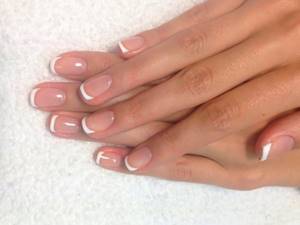
Reverse French.
A design with a highlighted hole will only be appropriate if you choose calm, neutral tones for it. The design can break up the monotony of a business environment, but it does not violate the strict rules of nail art.
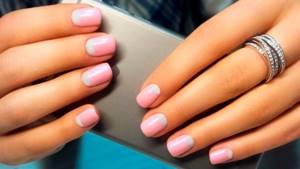
Design and drawings.
Stick to understated, minimalist designs, focusing on one finger.
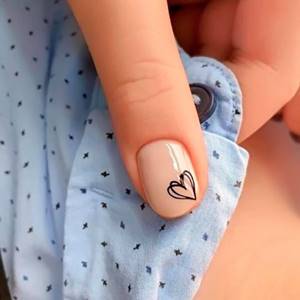
Technique for performing manicure without varnish at home
A manicure without varnish is performed in several steps.
Step 1. Removing the old coating (if any)
Before proceeding directly to the treatment of nails, you must first get rid of the old coating.

If your nails are covered with gel polish, you won’t be able to remove them without special tools. In this case, it is best to visit a specialist to remove the old coating.
Step 2. Cuticle treatment
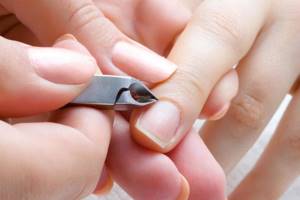
To do this, you need to hold your nails in a bath of warm water (you can add oils), then push back the sodden cuticle with a stick and carefully trim it with nail scissors.
Step 3: Sanding

Sanding is carried out using a soft file to eliminate all irregularities and make the surface of the nail plate uniform.
Step 4: Polishing
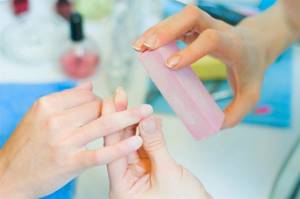
Polishing is done to give the nails shine. To polish your nails, you can use a buff or soft suede.
Step 5: Shaping your nails
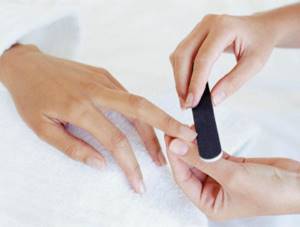
Using a suitable file, the nails are given the desired shape.
Koilonychia
Koilonychia is a spoon-shaped deformity that affects only the fingernails. Their surface becomes concave, but no change in thickness or structure is observed.
What do fingernails of such a rare shape indicate, what pathologies do they signal:
- Addison's disease;
- Iron-deficiency anemia;
- typhoid fever and other intestinal infections.
But still, most often the center of the plate is pressed inward due to mechanical injury, exposure to concentrated acid and alkali. Heredity should not be ruled out.
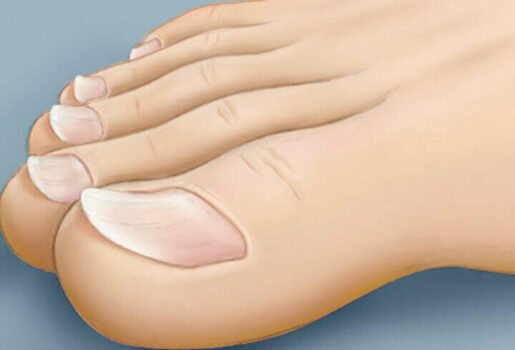
What does the color change mean?
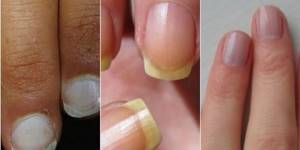
Everyone knows that a smoker's nails are dark yellow. But there are also plates with a completely unnatural shade, alien to the body. And most often it is caused by developed pathology.
Based on the color of the nails, the disease can be diagnosed by a doctor in a couple of minutes:
- green - Pseudomonas aeruginosa infection;
- reddish - chronic leukemia;
- whitish - cirrhosis of the liver;
- bluish with a purple tint - severe diseases of the cardiovascular system;
- yellow - any liver pathology, including fatty degeneration.
It is worth immediately clarifying that the doctor makes a preliminary diagnosis based on a combination of symptoms. Therefore, you should not panic or suspect oncological pathology if you notice a reddish tint. Redness of the skin under the nails may be a fungus, a sign of vitamin deficiency, or a consequence of removing red nail polish.

After menopause, you will have to shave your legs less often, and remove facial hair more often.
I regret to inform you that I have a mustache. To be honest, I probably always had them, but for many years they lay dormant in ambush and did not manifest themselves in any way, like clouds in the sky that may or may not burst into rain.
In my youth, my mustache darkened dangerously a couple of times. Then I went to the pharmacy and bought a huge jar of bleaching cream - it would be enough to bleach a hundred mustaches. (It is impossible to find a smaller jar on sale, since a small jar is cheaper than a large one.) When I returned home, in the cabinet under the sink I found several almost full jars of the same cream. But when I looked there before going to the pharmacy, they weren't there, I swear!
After the whitening cream, the hairs above my lip became light brown. It turned out, of course, better than Frida Kahlo's mustache, but not as invisible as I would have liked.
And then came menopause. And the mustache changed. They were no longer dozing in ambush, waiting in the wings; they came out of the shadows. Luckily, that’s when I started going to a wonderful Russian hairdresser, Nina, at a salon on the Upper West Side. Nina was doing hair removal with thread. She learned this amazing procedure in Russia, and, in my opinion, this is the only thing in which the Russians beat us in fifty years of the Cold War.
For hair removal you need regular sewing thread. They wrap it around your fingers and remove excess hair quickly and painfully (but not as painfully as, say, if you give birth). The results last for a month.
For a long time, threading has been a wonderful and effortless addition to my regular skincare routine. Twice a week Nina washed and straightened my hair, and it took about five extra minutes to remove the fuzz above my lip.
Plus another ten minutes to thin out my eyebrows, although under my long bangs you can’t even see whether I have eyebrows or not, and certainly no one can see in what condition they are. But if Nina took up her mustache, it seemed logical to her (and to me) that her eyebrows also needed to be adjusted.

Still from the film “When Harry Met Sally,” directed by Nora Ephron
Eyebrow thinning is a much more expensive and painful procedure (though still not as painful as childbirth). It causes uncontrollable sneezing. But the lack of a mustache is worth the trouble. By the way, the skin after epilation becomes delightfully smooth.
Alas, a couple of years ago I moved from the Upper West Side to the Upper East Side. I had to take my mustache with me, but leave Nina, since it became completely inconvenient for me to go to her. Travel time and taxi costs were now added to the cost of hair removal.
By the way, from the point of view of unwanted hair, menopause is not so bad: hair in different places begins to grow more slowly and you no longer have to spend as much time on it as before (this is not written in books about menopause).
As a child, I had a friend who became a pioneer of hair removal in America. She first waxed at age fifteen, in 1956. No one had heard of such procedures back then. A friend convinced me that if I don’t start waxing my hair, but shave it like the rest of the ignorant suckers, my hair will grow faster and faster, and at any moment I will turn into a bear.
It turned out that all this was not true. You can shave your legs for the rest of your life, and they will remain the same as they were. And then, when you reach a certain age, they will become less hairy. According to my calculations, at the age of eighty I will be able to deal with all unwanted hairs in a couple of seconds with the help of tweezers.
As for bikini area hair removal, it didn't last very long in my “beauty mode” (glossy magazines claim that everyone should have a “beauty mode”). Since I wear a swimsuit extremely rarely, I almost never need this procedure.
But in the good old days, it wasn't just painful—it was actually worse than childbirth. To endure the pain, I did the breathing exercises that we were taught in pregnancy courses. I highly recommend breathing techniques, although not for childbirth - they are useless there. But now, I understand that many young women are removing all their pubic hair or cutting it into curly bushes in the shape of triangles and hearts. Thank God I'm too old for all this.
Advertising
Why does the nail come off?
Almost every person in his life has encountered a situation where a nail has come off from a toe or hand. The most common cause of the incident is previous damage, impact or pinching of the horny plate. As a result, the nail may become deformed, change color and fall off.

Why is this happening? For example, you pinched your finger. Mechanical impact on the nail plate led to rupture of the vessels under it, possibly resulting in bruising. This will be followed by pain, redness of the plate and the finger itself. Over time, changes occur in the blood cells that lead to a change in the color of the resulting hematoma - it becomes green, blue or even yellow. A “bruise” is an area of tissue that is no longer attached to the base. For this reason, the hematoma gradually peels off and the nail leaves the finger.
Can a person have no nails at all?
Fingers without nails are obviously an unusual occurrence. Human nail plates are susceptible to a huge number of diseases, among which infectious diseases take pride of place. We are talking about candidiasis, pyoderma, etc.
Pathological changes in the nail can also be caused by nervous, mental, endocrine and other systemic ailments. It is impossible not to note the frequency of traumatic and occupational injuries to the horny plate. However, if the fingers are without nails at all, we are talking exclusively about a hereditary pathology - anonychia.
Structure changes

Often there are no visible deformations. The plates do not change color, do not bend, or become covered with dents or grooves. But the structure of the nails itself cannot be called healthy.
It is disrupted due to the following diseases occurring in the body:
- apalonychia, or fragility, can be triggered by chronic arthritis, hypothyroidism, peripheral neuropathies and angiopathy, exhaustion;
- thickening is usually caused by rheumatism, gout, atherosclerosis, on the legs - flat feet, clubfoot;
- thinning is characteristic of eczema, psoriatic arthritis, severe vitamin deficiencies, osteoporosis;
- fragility, delamination and cracking are observed with disturbances in the gastrointestinal tract, anemia, pathologies of the thyroid gland, diabetes mellitus, and cardiovascular diseases.
The cause of any change in the structure and appearance of the plates can be psoriasis, which affects the nails. It cannot yet be completely cured, but by adjusting the diet and taking medications, it is possible to avoid its exacerbations.

What to do with the cuticle?
Professional manicurists usually trim the cuticle to make the manicure look more aesthetically pleasing. But it is not recommended to do this at home yourself if you do not have the appropriate experience. Otherwise, you can get an infection, and you won’t have time for manicures for a long time after that.
You can remove the cuticle yourself without any improvised means, without even cutting it off. Simply push the cuticle towards the base of the nail with your other hand. Here the problem is solved.
Onychogryphosis - "bird's claw"
The diagnosis of nails of this shape is made quickly enough. They have the shape of a bird's claw - the plate is strongly curved, very dense, yellow, dirty gray or black. First, doctors rule out burns, frostbite, onychomycosis, and the consequences of wearing tight, uncomfortable shoes. And then they send patients to laboratories for examination for generalized candidiasis - a fungal infection of internal organs. It is extremely rare for the transformation into “bird claws” to occur in elderly people due to the natural aging of the body.
Panaritium or nail-eater
The disease is characterized by the occurrence of an acute inflammatory process near the nail bed. When the cuticle is dry, an injury, abrasion, or injection occurs, a purulent infection enters the tissue on the hand through the site of injury, which begins to spread rapidly. This happens:
- compression of blood vessels;
- eating disorders;
- formation of necrosis;
- suppuration;
- the occurrence of severe pain due to the presence of a large number of nerve endings in the nail bed area.
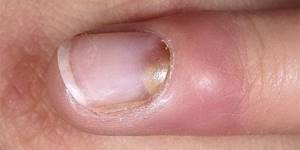
If the abscess has not formed, its formation is provoked by physiotherapy - dersanval, ultraviolet radiation. When felon causes unbearable pain and prevents sleep, surgical intervention is prescribed:
- perform pain relief;
- make an incision;
- do thorough drainage;
- remove necrotic tissue;
- apply a bandage with erythromycin, tetracycline ointment;
- antibiotics are prescribed.
Bleaching
This type of disease does not require special treatment and is considered the safest of all lesions of the nail surface. It is important to eliminate the factors causing discoloration and grow a new healthy plate. The causes of the unpleasant symptom are:
- use of low-quality varnish;
- smoking tobacco;
- rarely – anemia, weakened immunity.

